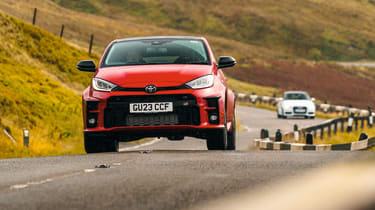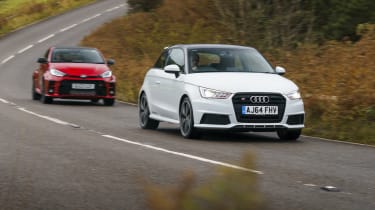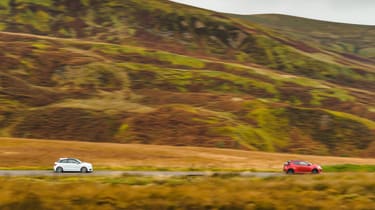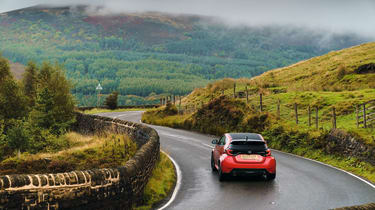Toyota GR Yaris v Audi S1 – four-wheel-drive hatches go head-to-head
They’re two dinky performance cars with startlingly similar recipes, but how does the decade-old Audi S1 compare to today’s much-hyped Toyota GR Yaris?
Homologation special. A phrase so fully loaded it can make your first few miles in the Toyota GR Yaris a little underwhelming. A Lancia 037 possessed neither a three-year warranty nor a nannying lane-keep system that reactivated every time you started the engine. But to sell the 25,000 cars necessary to meet modern World Rally Championship rules – as was Toyota’s target until Covid scuppered the rally version’s chances of being ready before the sport switched to hybrid machines – the broad-shouldered Yaris needed to conform at least a little.
There’s also the tidal wave of hype that brought the little Toyota to shore. Barely anyone blinked when the curious Yaris GRMN – a much underrated car – launched five years ago. Squeeze a punchy turbo engine and a four-wheel-drive chassis with a variable power split under some shrink-wrapped bodywork, however, and interest is more universally piqued.
> Toyota GR Yaris Gen 2 prototype 2024 review – rally‑bred hatch turned up to 11
It’s easy to imagine the folks at Audi Sport were a little miffed. Much of the GR Yaris recipe replicates that of the mighty little S1, a performance car almost a decade the Yaris’s senior. An only mildly diluted, higher-production-run version of the curious, 333-off A1 Quattro, it treads a similar line to the dinky Toyota but – as yet – doesn’t seem to have been paraded under the same ‘future classic!’ banner. Which is why a thoroughly decent example can be had for under £15,000, making an S1 the absolute definition of ‘half-price hero’ beside the £32,205 Yaris.
The latter edges this battle on paper. Its muscular 1.5-litre triple puts 257bhp and 265lb ft through just 1280kg for a 5.5sec 0-62mph time. Its four-wheel-drive system is more flexible, with three driving modes that can send up to 60 per cent of its power up front or 70 to the rear. But the S1 doesn’t languish in the GR’s wake, a 228bhp and 273lb ft tune of the ubiquitous EA888 2-litre four propelling 1315kg to sixty-two in 5.8sec. The dinky Audi also ushered in a then-fresh iteration of Haldex quattro; rather than being natively front-driven, it defaulted to a 60:40 front/rear torque split, heading to 50:50 when pushed. Crucially, both cars have the sole offer of a six-speed manual gearbox.
My early morning blast up to the Peak District reminds me that driving a GR Yaris is a layered experience and that this is not a car that gives up its A-game easily. You can accuse most hot hatchbacks of perching you too high, but you feel like a pianist on the Toyota’s pedals, while its balled gearknob sits an inch or two further away than you might ideally like. Grip is perennially strong and the sort of cheekily trailed brakes or lifted throttles that cajole lesser FWD hatches into life are met with a poker face here. It’s not especially multifaceted, either, tyre roar fighting the speakers hard on the motorway, and the rear quarters are both small and tricky to access thanks to a combative front-seat mechanism.
But when the light catches the shimmering WRC plaque on the GR’s transmission tunnel you’re minded to see such issues as inconsequential, even if the abundant promise of its mechanical layout feels buried much further from your grasp than its fit-to-burst bespoke bodywork might suggest. The Yaris found itself sandwiched in fourth place between a Ferrari and Lamborghini at eCoty 2020, even topping one judge’s scorecard, though its strong showing was accompanied with observations that still ring true today.
‘It’s a car that needs loads placed through its chassis for it to really come alive,’ said Adam Towler, a man usually found in almost sobbing reverence of a rally-inspired special. ‘Don’t mistake “coming alive” for pace or ability, because it has those in vast quantities from the off, but it’s just that it can feel a little sensible, almost slightly inert unless there’s enough lateral, longitudinal and yaw forces to unsettle it.’
Which is all the encouragement needed to push harder. It’s a wet and grimy day on Holme Pass and you’re initially greeted with understeer when you up your pace and commitment in the GR. It may be a safety net that’s applied to most modern cars, but it’s more prevelant here than you’re perhaps expecting. This particular car is also fitted with the Convenience Pack, which trades the more desirable mechanical Torsen differentials on each axle of the Circuit Pack cars for a posher stereo and a head-up display, and the drop off in precision and a playfulness is instantly apparant.
You need to be more aggressive to bully the rear end into action. In Normal mode there’s a 60:40 front/rear torque split but switching to Sport flips this to 30:70. I’m not sure it ever fully feels it, the car remaining so planted and adept at typical road speeds. By comparison, its GR86 sibling immediately demands your attention – especially in conditions like today’s. The Yaris is distinctly more foolproof, a feeling echoed as you change gear. More than once I miss-shift up to fifth rather than third. User error, or a bit of mechanical mollycoddling for those migrating from twin-clutch Golf Rs, the gearbox favouring its higher plane to avoid an expensive mishap? Either way, there are no such missteps with the wonderful manual gate of the S1, its milled metal knob moving so deftly that you’d swear Audi was a stick-shift specialist and this wasn’t a pleasingly analogue anomaly in its recent history.
The S1 you’re looking at belongs to fellow automotive journalist Ted Welford, who picked it up mere weeks ago. It wears its nine years and 66,000 miles phenomenally well, feeling plusher and better screwed together than the almost showroom-fresh Toyota. Where the Yaris proved a plucky underdog at eCoty, the S1 finished dead last in 2014, albeit a year in which the Ferrari 458 Speciale basically eclipsed everything that dared share a Scottish Borders lay-by with it. Our judges loved the sheer quality emanating from the Audi but found the other hot hatches present – a Mégane 275 Trophy R and that pesky Mk7 Golf R – simply cast too much shade on it.
Almost a decade on, its premium feel remains. As I clamber into the surprisingly snug and low-slung Super Sport seat – a welcome element of his example’s £8230 raid of the options list – Ted showers me with cautious caveats, most of which relate to the ride quality. He needn’t have worried. As soon as I’ve pulled out onto the road and snuck from first to second gear I remember just how great these felt new.
Where the Toyota leans more heavily into being a highly strung rally-rep, the Audi feels like a dextrous hot hatch with welcome depth. Each of its controls melds sweetly into the next, the weighting of them all finely matched to create an exquisitely cohesive package that you immediately go tearing into the heart of. ‘The S1 is a refreshingly carefree car to punt along,’ said Dickie Meaden during eCoty 2014, ‘and is cohesive and consistent in a way many quick Audis fail to manage.’
Cars this neatly honed don’t always suggest themselves as icons, being too clean-cut to really prickle the hairs on your forearms as you start the engine. Yet when that familiar 2-litre blares into life, that’s exactly what happens, the sound so much deeper and harder-edged than the curious thrum of the GR. Crucially the S1 feels big-hearted, exhibiting that glorious over-engined feel that all the most enticing hot hatches possess. A handsomely tuned four-cylinder still beats a three for appeal, I’m afraid, and boy can this particular four be affordably and dramatically modified should you ever feel the need. I kinda hope you don’t.
The steering is light but relays more information than I dared expect and the whole chassis feels squat and square, reacting excitably to the sort of mid-corner inputs the Yaris shrugs off. While not an outright extrovert, the Audi reacts deftly to a lift of the throttle and you feel each corner of the car working hard to point the nose quickly out of a turn. Begin to take more liberties and there’s even more fun to be had. All with that slick manual shift playing a starring rather than supporting role throughout.
I’m relieved Audi never offered a DSG, as the final bill for this car – over £33,000 once its first owner added Quattro exterior and interior styling packs, a panoramic roof, Bose stereo and satnav – suggests it would have been an all-too-easily ticked box if you felt intent on raiding the options list. For a car made of such relatively run-of-the-mill Volkswagen Group parts, the S1 comes away feeling like a bespoke package, a real sweet spot in everything the wider group did well. All while presenting a curious exception to many of the usual fast Audi rules.
It’s almost a shame there’s no actual motorsport kudos here, for it’s easy to see why such a magnetic draw pulls enthusiasts inexorably to the Toyota. It’s also hard not to wonder why this set-up wasn’t allowed near the VW Polo R WRC, an oddball FWD special that helped homologate Séb Ogier’s stomp into the World Rally history books but which never made it to Great Britain. (I don’t think we missed out.) Audi sold 3211 examples of the S1 in the UK between 2014 and ’18, while 1835 GR Yarises have been registered since 2020. Both will remain relatively rare beasties.
The Audi more convincingly nominates itself as a daily driver with its slightly bigger boot and classier ergonomics. It sits 25mm lower than a stock A1, yet both of its damper settings work nicely on a crumbling British B-road, meaning you’re highly likely to prod the Drive Select into the most dynamic of its three modes and just get on with it. There’s no Individual setting, but you won’t miss it.
The Toyota offers a greater breadth of choice, and once you’ve held down the lane-keep button to deactivate its most annoying nanny, you’ve a toy box of other buttons and dials to play with. Its auto rev-matching defaults to off but can be activated independently of drive mode. Those are chosen via a circular dial that notches between Normal, Sport and Track, but with a passive suspension set-up these focus only on the torque split. I keep it in Sport all day, craving that elusive interaction, feeling like I need Jonne Halttunen screaming pace notes at me to really dig appropriately into its deep reserves. The fact Toyota went to the effort of cutting drive to the rear wheels when you yank its manual handbrake suggest this is a car made for having fun slightly on the fringes of the real world. Which is marvellous when the situation presents itself, but a little frustrating the vast majority of the time it doesn’t.
Having effectively used the more approachable Audi as my recce car, I head for one final run in the Toyota before Dean Smith packs away his tripod for the day. While stopping short of a full epiphany, it’s clear the slower burn of the Yaris is winning me over. The S1 feels accomplished across this terrain but the GR is a revelation – just so finely tuned for a grisly, bumpy back-road that it’s clearly been developed far beyond the usual parameters for such a surface. I think you’d especially relish wet days and how much louder they make the pulse of the car. A proper rally rep, then. Its quick steering yields urgent reactions, while the muscles in your left hand will always be tingling, ready to keep the engine bubbling above 3000rpm and thus avoid the lag and slight lumpiness below. Give the Yaris hell and it bursts to its 7000rpm red line like a student to an alcopop deal.
As your confidence grows, so does the pace the GR draws out of you. It’s perhaps paradoxical that while the Toyota has a longer, more satisfying arc to its dynamics, the Audi feels better prepared for longevity. The GR’s flimsy parcel shelf and thin ‘suede’ door cards would appal you if you weren’t so acutely aware of how aggressively your money has been directed at the chassis instead. Not only would its price tag look much less tantalising if it were inflated by the adoption of plusher materials, but Toyota’s focus on weight saving might have fallen a little flat too.
Different twists on a similar recipe, then, but both cars fully deserve to be celebrated. Did either of them truly need building from a profit point of view? Surely honing such bespoke packages risks taking a slice from a company’s bottom line rather than cementing it. As enthusiasts, we can just be glad they exist – each knows how to keep your gaze fixed purely on fun. Whether you commit £350 a month to a nicely warrantied GR Yaris or spend less than the cost of a new Aygo on the alluring S1, you’ve placed your bum firmly in the seat of an evo hero.
Specs
| Audi S1 | Toyota GR Yaris | |
| Engine | In-line 4-cyl, 1984cc, turbocharged | In-line 3-cyl, 1618cc, turbocharged |
| Power | 228bhp @ 6000rpm | 257bhp @ 6500rpm |
| Torque | 273lb ft @ 1600-3000rpm | 265lb ft @ 3000-4600rpm |
| Weight | 1315kg | 1280kg |
| Power-to-weight | 176bhp/ton | 204bhp/ton |
| 0-62mph | 5.8sec | 5.5sec |
| Top speed | 155mph | 143mph |
| Price when new | £24,900 (2014) | £32,205 |
This story was first featured in evo issue 316.









